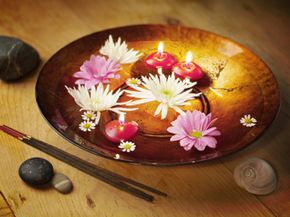The last time you got a cold, you probably didn't think of your phlegm as a divine force. Nor is it likely you've contemplated the spiritual significance of your bile. But in Ayurvedic medicine -- an ancient practice that originated in India 5,000 years ago -- having balance among these bodily fluids in your system is essential to good health.
Ayurveda, which means "science of life" in Sanskrit, is based on the premise that everything in the universe, including the human body, is comprised of five basic elements: earth, wind, fire, water and space [source: Ayurveda Institute]. Each
Advertisement
of these elements is present in our bodies in various proportions in what are called doshas. Keeping those doshas balanced through diet, exercise, herbs, massage and meditation is the basis of Ayurveda medicine [source: Chopra].
According to Ayurveda, each person is born with a unique composition of the three doshas -- vata, pitta and kapha -- that determine our physical and psychological makeup like whether we are fat or skinny, slow or quick moving, easy going or anxious. It also determines what type of diet, exercise and treatment we need to prevent illness.
Those who are predominantly vata tend to be thin, quick thinking and prone to constant change. When in balance, vatas are lively, creative people. But when they become unbalanced, they are prone to anxiety, insomnia and indigestion [source: Chopra].
People who are mostly pitta tend to be muscular, intense and ambitious. In balance, they are friendly, smart and strong leaders. Out of balance, they can be critical, irritable and aggressive [source: Chopra].
Kaphas tend to have heavy frames and calm natures. In balance, they are sweet, loyal and the vision of serenity. But out of balance, they are prone to weight gain, congestion and resistance to change [source: Chopra].
In India, viewing the body through this energetic prism has been part of the culture for centuries, as well as in countries like Sri Lanka, Bangladesh, Nepal and China. In the U.S., the rise of Ayurveda is a recent phenomenon, one of a growing list of New Age treatments like acupuncture, massage, yoga, chiropractic, meditation and herbal medicine gaining a foothold in mainstream medicine.
Read on to find out how practitioners learn this ancient healing practice.
Advertisement
